Have you ever thought about Batanes’ location? Is it in Luzon or a different Philippine region? Let’s find out more about Batanes. We will see where it really is.
Batanes is a group of islands in the Philippines. It’s famous for its untouched beauty and deep culture. People call it the “Scotland of the East” because of its lush hills and stunning scenes. Yet, its regional link confuses some.
Many think Batanes stands alone. But it’s actually part of the Cagayan Valley region. It lies in the far north of the Philippines. Batanes falls under the Cagayan Valley’s governance, with others like Cagayan, Isabela, and Nueva Vizcaya.
Key Takeaways:
- Batanes is a captivating province known for its scenic beauty and rich cultural heritage.
- Contrary to popular belief, Batanes is not an independent region but is part of the Cagayan Valley region in the Philippines.
- The province is situated in the northernmost part of the country and is administratively under the jurisdiction of the Cagayan Valley region.
- Exploring Batanes will give you the opportunity to immerse yourself in its stunning landscapes, unique traditions, and authentic cuisine.
- Plan your trip to Batanes and discover the beauty and charm of this hidden gem in the Philippines.
Geography and Location of Batanes
Batanes is an archipelago province at the very north of the Philippines. It has 10 islands, but only Batan, Itbayat, and Sabtang have people living on them. This place is nestled between the Luzon Strait, the Balintang Channel, and close to Taiwan.
It has the South China Sea on one side. The other side faces the Pacific Ocean. This special spot makes Batanes the most northern part of the country.
Mavudis Island is also known as Yami. It’s the furthest island in the north of Batanes.
Batanes is famous for its beautiful natural scenes. You’ll find green rolling hills, sheer rocky cliffs, and untouched beaches. These were shaped by its closeness to the sea and the weather’s forces.
Soon, we’ll dive into the rich history of Batanes. Let’s uncover the amazing tales that define this magical place.
Historical Background of Batanes
The story of Batanes is a captivating journey of endurance and culture. It began 4,000 years ago with the Austronesians. They settled here, laying the foundation for the Ivatan people. Early settlements and trade show the area’s historical richness.
In 1783, the Spanish added their mark, deeply influencing local culture and buildings. American rule later folded Batanes into the Philippines’ diverse culture mix.
Batanes has braved both leadership struggles and natural disasters. World War II’s scars, from the Japanese occupation, molded its unique identity.
“The history of Batanes is a testament to the strength and resilience of its people, who have overcome adversity and preserved their unique cultural heritage.”
Cultural Heritage
Batanes proudly highlights its unique culture. The Ivatan people hold onto their traditions. Among these is the ingenious “Lime and Stone Houses,” designed to outlast typhoons.
The land’s farming and fishing practices tie closely to its culture. These activities support the community and its growth.
Trade and Connections
Batanes has long been a key player in trade. Its prime position by the Taiwan Strait and Balintang Channel boosted its maritime role.
Its location also fostered cultural exchanges with nearby lands. These have shaped the Ivatan language and traditions.
Batanes offers a rich mix of history, culture, and stunning scenery. Its past continues to influence its identity today. This makes it a fascinating place for anyone interested in history or looking for an adventure.
Unique Cultural Heritage of Batanes
Batanes is known for its rich culture and traditions. The Ivatan people have kept their way of life alive through the ages. They pass it from one generation to the next.
The stone houses in Batanes are amazing. They’re made of limestone and coral stones. These houses stay cool and can survive big storms. They show the Ivatan’s skills and are a big part of Batanes’ image and spirit.
The Ivatan’s main jobs are farming and fishing. They grow garlic, wheat, and other crops in rich soil. The sea around them offers plenty of fish. This makes their life closely tied to the land and the ocean.
In Batanes, people speak Ivatan, Ilocano, Tagalog, and English. Keeping their language alive helps maintain their community and culture. Their language carries their history, traditions, and stories through time.
Traditional Ivatan Cuisine
Batanes also has a rich food tradition. Ivatan dishes come from the land and sea. They use fresh seafood, root crops, and more.
The coconut crab, or “tatus,” is a special dish here. It can be cooked in many ways. Other favorites include vakul-wrapped rice and taro leaf soup known as “uvud.”
They also enjoy drinks like palek, a sugar cane wine, and kakanin, rice treats. These foods and drinks offer a true taste of Batanes and its people.
Art and Handicrafts
Art and crafts are important in Batanes. The Ivatans are skilled in weaving and stone carving.
Ivatan women weave beautiful items from vakul leaves. These things are not just useful; they’re a part of their identity and creativity.
Stone carving is another key art form. Carvers make lovely sculptures and decorations from limestone. You can see these works all over Batanes, adding beauty to many places.
“The unique cultural heritage of Batanes shows the Ivatan people’s resilience and creativity. From their stone houses to their food and crafts, Batanes reveals a deeply kept cultural world over many years.”
Batanes Cultural Heritage Highlights
| Cultural Heritage | Description |
|---|---|
| Lime and Stone Houses | Traditional houses built to withstand typhoons |
| Agricultural Heritage | Farming and fishing as main livelihoods |
| Ivatan Language | Preserving the unique language of the Ivatan people |
| Art and Handicrafts | Intricate weaving and stone carving |
Batanes’ culture is a rich, living story of the Ivatan people. Their stone houses, food, and crafts show their skill and spirit. Discovering Batanes’ culture connects us with the Ivatan’s traditions and values.
Tourist Attractions in Batanes
Batanes is a beautiful province with many tourist spots. It’s perfect for adventure lovers, nature fans, or anyone interested in history. Here are some top places you should visit in Batanes:
1. Mount Iraya
Mount Iraya, a dormant volcano, is great for hikers and those who love nature. It stands 1,009 meters tall and gives amazing views of Batan Island and its landscapes. Trails are open for both new and seasoned climbers.
2. Radar Tukon
Radar Tukon sits on Basco’s Tukon Hill. It was an old United States weather station. Now, it’s a perfect spot to see Batan Island’s beauty. You can see rolling hills, the vast sea, and green landscapes from here.
3. Chawa Cave
Chawa Cave is a secret spot waiting for you. It has beautiful rock shapes and a clean underground stream. It’s a special place for those seeking adventure. You can explore its parts and see its geological beauty.
4. Diatay Beach
Diatay Beach is quiet and beautiful, with clear waters and soft white sand. It’s great for relaxing, having picnics, and walking on the beach. You can sunbathe, swim, or enjoy wandering along the shore.
5. Naidi Hills
Naidi Hills is a well-known spot in Basco, the capital of Batanes. An iconic lighthouse sits on a hill. It provides amazing views of Batan Island, the mountains, and the sea. Photographers and nature lovers adore this place.
6. Valugan Bay
Valugan Bay has interesting rock formations with big boulders on the beach. The rough rocks and peaceful scenery are stunning together. Walking on the beach makes you feel calm and amazed by nature’s beauty.
Batanes has many wonderful places to visit. You can explore nature, learn about history, or enjoy stunning views. Batanes will give you memories that last a lifetime.
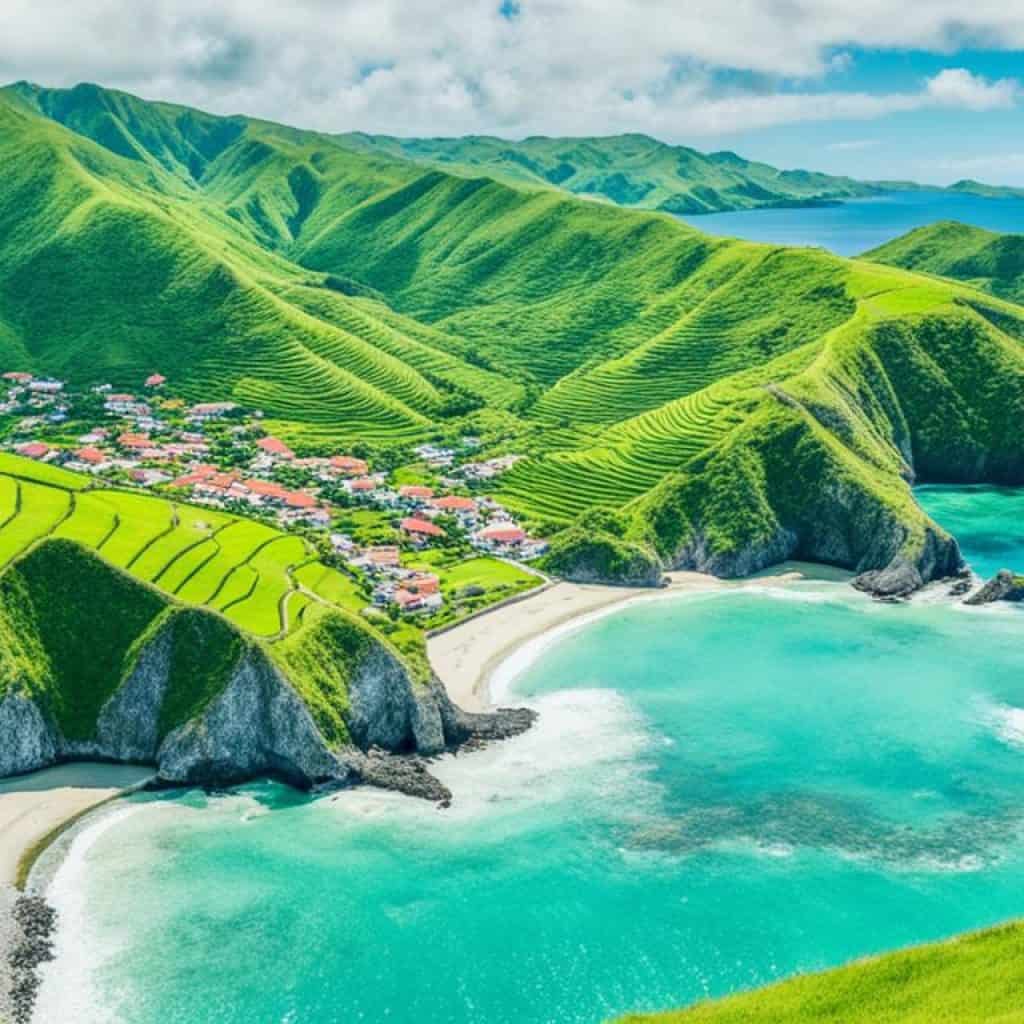
Exploring the Islands of Batanes
Batanes is made up of several unique islands. These places offer different experiences for visitors. Let’s look closer at some key islands and their special features:
Batan Island
Batan Island is the busiest. It hosts the capital, Basco, offering places to stay, eat, and more. Basco Port is great for sea views, starting boat tours. The famous Sto. Domingo Church, or Basco Cathedral, is a key landmark with deep religious history.
Sabtang Island
Sabtang Island lies southwest of Batan. It’s famous for pristine beaches and the Chavayan village with traditional stone houses. This shows the Ivatan people’s unique architecture. Visitors can dive into local culture and learn about traditional lifestyles here.
Itbayat Island
Itbayat Island is the biggest but least visited, perfect for those seeking adventure. It’s known for Sarokan Cave’s impressive rocks. The island also has burial caves, giving insight into ancient Ivatan traditions.
Mavudis Island
Mavudis Island is the farthest north in Batanes, providing stunning views. On clear days, you can even see Taiwan. It’s ideal for quiet walks, picnics, and sea views. This spot offers peaceful relaxation away from crowds.
Each island in Batanes brings something unique, ensuring a memorable trip. You’ll find history, natural beauty, or cultural experiences. Batanes invites everyone for an adventure.
Explore the islands of Batanes and discover the beauty and charm that awaits you!
Cultural and Historical Sites in Batanes
Batanes is a region filled with history and culture. It’s known for its significant landmarks. These sites let visitors see the past and marvel at the region’s architecture.
The San Carlos Borromeo Church in Mahatao is a must-see. Built in 1789, it’s a National Cultural Treasure. It shows the province’s strong religious past. Inside, you’ll find old carvings and artifacts that take you back to Batanes’ colonial days.
The Ruins of Songsong in Uyugan are fascinating for history buffs. This ghost village has structures with no roofs, left behind after a tidal wave in the 1950s. They remind us of the area’s fights with nature and its people’s resilience.
In Ivana, the Ivana Ruins offer a peek into Batanes’ architectural legacy. Nearby, the Honesty Coffee Shop stands out with its trust-based self-service. Another treasure, the House of Dakay, is among Batanes’ oldest traditional stone houses. These spots offer a real taste of the region’s history and culture.
“These cultural and historical sites in Batanes are not just remnants of the past, but living testaments to the enduring spirit of its people.”
Visiting these sites in Batanes is like diving into the province’s colorful history. You get to see architectural wonders that have lasted for ages. It’s a trip that connects you with the rich story of Batanes and its unforgettable past.
| Attraction | Location | Highlights |
|---|---|---|
| San Carlos Borromeo Church | Mahatao | National Cultural Treasure, centuries-old features |
| Ruins of Songsong | Uyugan | Ghost barangay, abandoned houses after a tidal wave |
| Ivana Ruins | Ivana | Crumbled structures, architectural heritage |
| Honesty Coffee Shop | Ivana | Unique self-service based on trust |
| House of Dakay | Ivana | Oldest surviving traditional stone house |
Natural Wonders of Batanes
Batanes, known as the “Home of the Winds,” is a breathtaking province in the Philippines. It showcases stunning natural beauty and captivating landscapes. Its landscape features rolling hills, rocky cliffs, and beautiful beaches. These allow visitors to connect with nature deeply.
Valugan Bay is a must-visit in Batanes. This bay has multi-colored rocks, creating a stunning view by the sea. It’s perfect for taking photos and feeling nature’s raw power.
If you want a peaceful beach, Diatay Beach is perfect. It has white sand and clear waters. It’s a hidden gem for swimming, sunbathing, or walking by the sea.
For breathtaking views, go to the Communal Pasture Land. This vast area offers amazing views of hills and the ocean. It’s the best spot for those seeking peace and a connection with nature.
But Batanes’ beauty isn’t just by the sea. Inland, mountains and slopes add to its charm. Whether hiking or driving, the mountain views will impress you.
Experience the untouched beauty of Batanes. Every view is like a postcard. The natural wonders here show the powerful beauty of nature. Batanes is truly one-of-a-kind.
Authentic Ivatan Cuisine
Batanes is famous for both stunning scenery and its unique Ivatan cuisine. This local food showcases the area’s farming and sea resources. Favorites include coconut crab (tatus), vakul-wrapped rice (tayid), and taro leaf soup (uvud).
They often use fish, root crops, coconuts, and tubers. Traditional drinks like palek (sugar cane wine) and kakanin (rice delicacies) are loved by many.
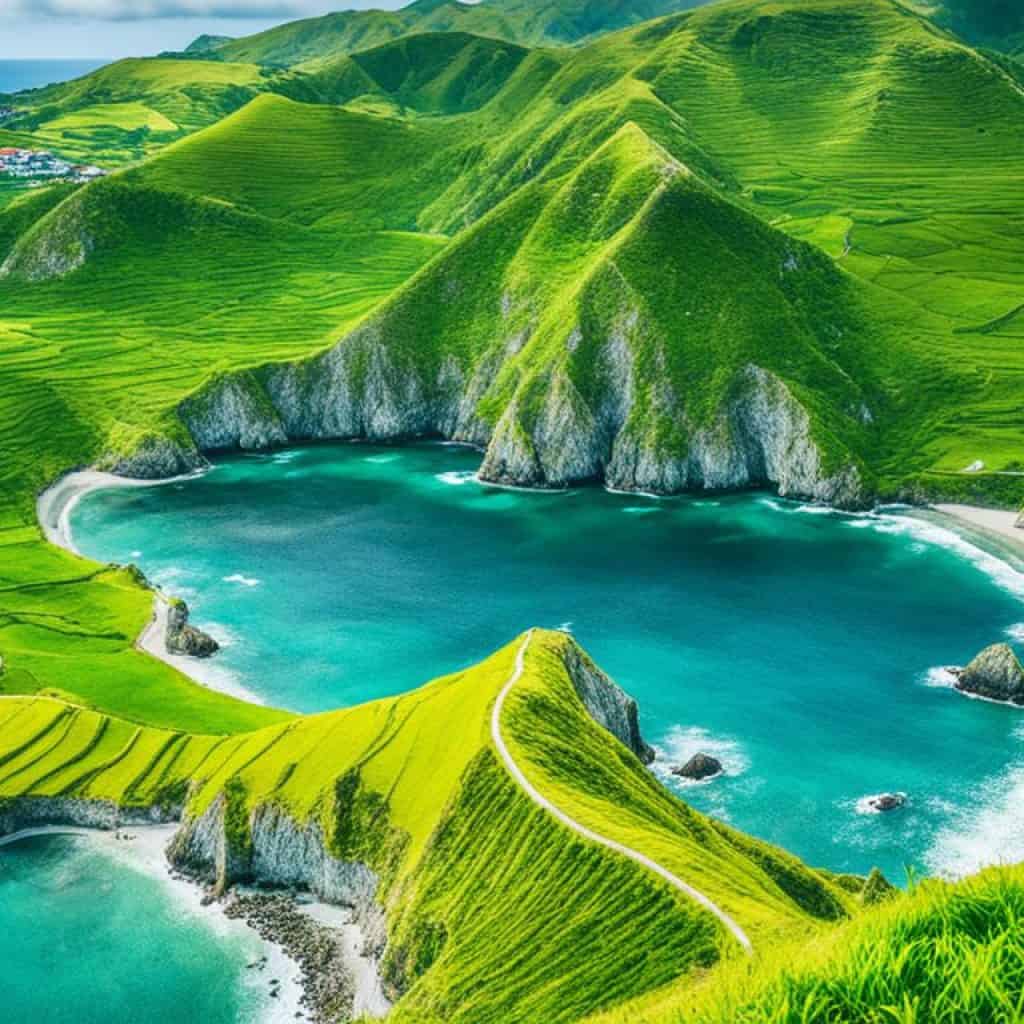
Getting to Batanes
Batanes is at the very top of the Philippines. It’s a distant yet enchanting area with a special travel vibe. You can get there by flying or sailing.
By Air
The easiest and most common way to visit Batanes is by flying. Flights go from Manila to Basco Airport. This flight takes around one hour. You get to see awesome views of the Philippine coast from above. Flying starts your Batanes trip in an exciting way.
By Sea
If you’re up for a different journey, take a ferry from Manila or nearby places to Basco. Traveling by sea is slower than by air. But, it lets you see the beauty of the Philippines from the water. It’s perfect for those who like relaxing trips with great views.
When planning your Batanes visit, think about the weather. Batanes often faces typhoons. Travel plans can change if the weather gets bad. Always check for travel updates and plan well for a great trip.
“Getting to Batanes is an adventure in itself. Whether you choose to soar through the sky or sail across the sea, the journey sets the stage for the unique experiences that await in this captivating province.” – Travel Enthusiast
Accommodations and Facilities in Batanes
Batanes offers a variety of places to stay, from luxury hotels to cozy bed and breakfasts. You’ll find something that fits both your taste and budget in this lovely area. This makes the province a great choice for any traveler.
In Basco, the capital, there’s a range of places to stay. You can choose from hotels, resorts, and inns. Whether you’re looking for luxury or something more homey, Basco has what you need.
If you want to dive deeper into the local culture, try a homestay. You’ll live with a local family. This is a great way to learn about their traditions and way of life.
Besides Basco, towns like Mahatao, Ivana, Uyugan, Sabtang, and Itbayat also have great places to stay. Wherever you stay in Batanes, comfort and a warm welcome are guaranteed.
It’s smart to book your stay early, especially in the peak season. This ensures you get the best choice without the stress. Picking the right place in Batanes can help make your visit truly memorable.
Accommodation Options in Batanes
| Accommodation Type | Location | Features |
|---|---|---|
| Luxury Hotels | Basco | Spa, pool, gourmet dining |
| Resorts | Basco | Beachfront location, recreational activities |
| Inns | Basco | Cozy rooms, friendly atmosphere |
| Homestays | Various towns | Immersive cultural experience |
Discover Batanes’ stunning beauty while staying in comfort. Remember to book early. Enjoy your visit to this beautiful province to the fullest.
Conservation and Sustainability Efforts in Batanes
Batanes is famous for its stunning scenery and rich culture. It is also committed to keeping them safe for the future. To do this, the province has started many efforts to protect its natural places and lessen its harm to the environment.
Promoting Responsible Tourism
Batanes aims to find a good balance with tourism. They want to welcome visitors but keep the environment safe. Tourists are taught to travel responsibly. They learn to reduce waste, respect the culture, and support local shops.
Reducing Plastic Waste
The province is working to cut down on plastic waste. It aims for a cleaner place. Hotels, restaurants, and other places are using less plastic. There are also projects to handle plastic waste better. This helps keep Batanes’ nature clean.
Supporting Local Livelihoods
Batanes also helps its people make a living in sustainable ways. It backs tourism that benefits the community. This helps save cultural practices. Visitors get to really experience the local life. It also supports the area’s growth.
“Batanes’ conservation efforts are a testament to the province’s dedication in preserving its natural beauty and cultural treasures while ensuring the well-being of its people and the environment.”
The Ivatan People: Guardians of Tradition
The Ivatan people are key to saving their culture. They share their traditions and lifestyle. Through festivals and workshops, they make sure their heritage lives on.
| Conservation and Sustainability Efforts | Impact |
|---|---|
| Responsible Tourism Promotion | Minimizes negative environmental and cultural impacts of tourism |
| Plastic Waste Reduction | Preserves the pristine natural beauty of Batanes and prevents pollution |
| Support for Local Livelihoods | Ensures economic opportunities for local communities and sustainable development |
| Preservation of Cultural Heritage | Protects Ivatan traditions, customs, and way of life |
Batanes sets an example with its environmental care and cultural preservation. It shows how tourism can be responsible. The province ensures that its wonders will be there for future generations to enjoy.
Conclusion
Batanes is a hidden gem in the Philippines with unmatched beauty and history. It offers stunning landscapes and warm hospitality. This makes it perfect for any traveler.
You’ll love the breathtaking views and cultural sites. Plus, the authentic Ivatan cuisine is a must-try. Batanes is a getaway from busy city life. It reconnects you with nature and history.
It’s time to plan your trip to Batanes. You’ll embark on a cultural adventure. Create unforgettable moments in the heart of this beautiful island province.
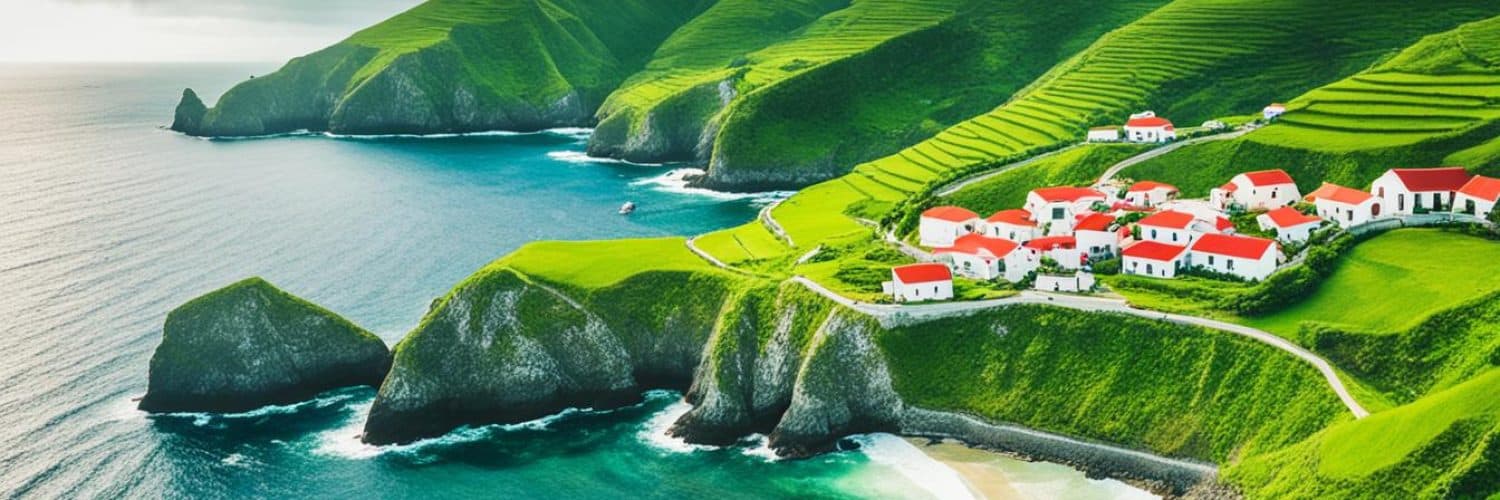
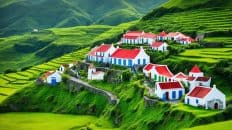
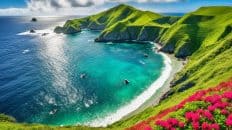
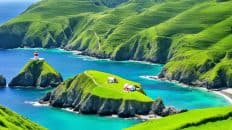














Add comment